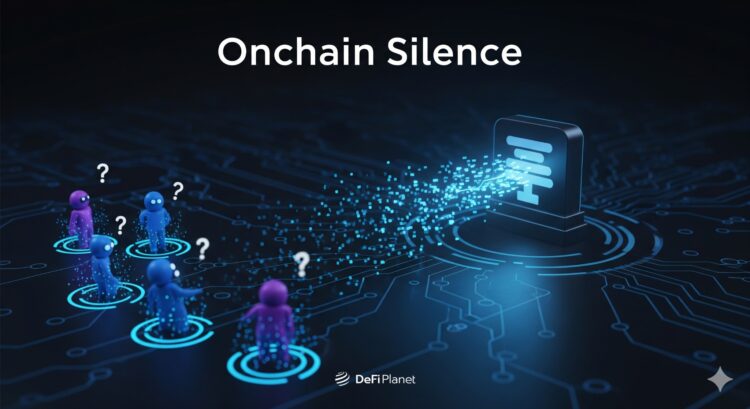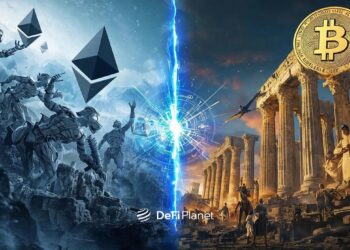In traditional apps, when something doesn’t respond, it usually means something is broken, but in Web3, silence isn’t always a bug; it could be part of the protocol design. Smart contracts are the rules that live on the blockchain and tell apps what to do. But what happens when those rules decide not to say anything at all? This article examines the idea of onchain silence, where smart contracts choose not to respond, and what it means for users, developers, and the future of blockchain.
What Is Onchain Silence?
Most of the time, we expect smart contracts to act immediately, and when you send a transaction, the contract updates your token balance, votes on a DAO proposal, or mints your NFT. But some contracts are built with programmable refusal, meaning they might intentionally delay, ignore, or even fail to process certain actions based on certain conditions.
This kind of silence isn’t accidental, and it’s part of how some systems manage liveness issues, which are problems where a program doesn’t respond in time or at all. Unlike bugs, on-chain silence is sometimes built in to make a system safer, more flexible, or even more fair.
Why Would a Smart Contract Stay Silent?
Smart contracts sometimes stay silent for good reasons; they might be trying to reduce spam, avoid risky behaviour, or stop certain actions during a system upgrade. For example, a decentralized exchange (DEX) might pause all trades if prices are swinging wildly to prevent a crash. Or a governance protocol might delay votes until more people have time to join.
In these cases, silence becomes a way to add more control or safety to a decentralized system. It can also signal that a system is waiting for onchain logic, specific conditions to be met. Until then, it just doesn’t act.
Smart Contract Latency and Transaction Failures
Latency means delay, and on blockchains, it can cause real problems for users. When you interact with a smart contract like borrowing crypto, swapping tokens, or minting an NFT, you expect the process to work quickly. But sometimes, it doesn’t. That delay is called latency, and it can happen for different reasons. One major cause is network congestion, where too many people are trying to use the blockchain at once and complex smart contract logic is another cause for smart contract latency.
When a smart contract is too slow or gets stuck, your transaction might fail. This means you could still pay a gas fee and sometimes a lot, but your request doesn\’t go through. Imagine paying for something and not getting it, with no refund. That’s what makes failed transactions frustrating. Sometimes, a transaction fails because the contract is too busy, and other times, it’s because the contract is doing its job by stopping parameters that don’t meet certain rules.
READ ALSO: Web3 Security Gets Real: Investing in Smart Contract Risk Management
For example, a lending app might have a rule that says you can only borrow if you offer enough collateral, and if you try to borrow without meeting that limit, the contract might reject your request automatically and silently. To the user, it may seem like nothing happened, but in reality, the smart contract was protecting the system. This can be confusing, especially for people who are new to crypto or don’t speak the language the error messages are in.
A failed transaction with no clear explanation makes people feel like something is broken, even if the contract is just being cautious, and when that happens, it can push users away from Web3 platforms entirely.
To fix this, developers are working on better tools to help users understand why a transaction failed. Some apps now give clear alerts or messages when things go wrong. Others let users simulate transactions ahead of time, so they can see if it will work before paying gas fees. These features can help make smart contracts easier to use and trust.
In a truly inclusive Web3, understanding a failed transaction shouldn\’t require coding knowledge or English fluency. Clear feedback, good design, and translated explanations can help make blockchain tools less frustrating and more accessible for everyone
When Silence Is a Feature, Not a Bug
Not all silence is bad, with some protocols using silence to manage risk or maintain fairness. Think of it like a red light; it stops action for a reason. For example, in some decentralized finance (DeFi) apps, contracts may not respond until enough confirmations are received from oracles. This reduces the risk of manipulation.
In NFT auctions, silence might mean the system is waiting for the auction to end before taking action; in DAOs, it can mean a proposal hasn\’t reached the minimum quorum yet. These quiet moments are part of how decentralized logic works.
The Risks of Silence
While silence can protect users, it can also be confusing because, if users don’t understand why a contract isn’t responding, they might think the system is broken. Worse, nefarious actors could use programmable refusal to manipulate markets or censor users.
This is why protocol transparency is important, with developers needing to explain when and why contracts might go silent. Otherwise, users lose trust, and in some cases, attackers might even create fake contracts that pretend to be silent but are actually stealing funds.
Designing for Clarity and Trust
A well-designed protocol should always try to be open and helpful, and that means having clear documentation that explains how things work, making the code open-source so others can review it, and listening to users when they have questions or problems. These things help build trust because when users can read how a system works and see that the team is being transparent, they’re more likely to stick around, even when things go wrong.

Some projects take it a step further by providing users with tools to try things out safely before taking real risks. For example, simulators and testnets allow people to see what a transaction will do before they spend any money on gas fees. If something might fail or be rejected, the user can learn about it in advance, rather than finding out the hard way.
Decentralized apps (dApps) can also help by showing warnings or alerts when contracts are likely to be inactive or overloaded. This helps users avoid wasting time and money. For example, if a staking contract is paused or under maintenance, the app can display a message instead of letting people submit failed transactions.
There are also third-party tools that help users understand what’s going on behind the scenes. Platforms like Tenderly, Etherscan, and Blockscout let people explore the blockchain to see exactly what happened during a transaction. They show details like gas used, contract steps, and error messages, almost like a report card for every action on the blockchain. These tools are especially helpful when a transaction fails or something unexpected happens.
When tools are designed to explain, not confuse, users feel more in control, and they stop seeing the blockchain as a “black box” and start understanding how to interact with it safely. This kind of clarity is crucial for building trust, especially among individuals new to Web3 or who don’t speak English as their first language.
A New Kind of Dialogue in Web3
In a world where onchain logic can choose when to speak, silence becomes part of the language. That means developers and users need to listen not just for answers, but also for the lack of them, and a non-response might be telling us that conditions aren’t right, that the system is protecting itself, or that something more complex is going on.
As Web3 systems grow, the role of silence will evolve too, with contracts gaining smarter ways to explain why they’re not acting. Oracles may provide clearer signals, and DAOs might develop systems to handle protocol liveness without losing control. In the end, smart contracts don’t have to be silent or mysterious and with better design, clearer feedback, and more user-friendly tools, we can build a Web3 that feels safe, fair, and open to all.
Conclusion
Smart contract latency, transaction failure, and programmable refusal are not just technical terms; they’re signs of how Web3 is building its own rules for communication and control. When smart contracts go silent, it’s not always a bug; sometimes, it’s part of a deeper design to make decentralized systems safer, smarter, and more responsive to real-world conditions.
As we move forward, listening closely to the silence may be just as important as listening to the code.
Disclaimer: This article is intended solely for informational purposes and should not be considered trading or investment advice. Nothing herein should be construed as financial, legal, or tax advice. Trading or investing in cryptocurrencies carries a considerable risk of financial loss. Always conduct due diligence.
If you want to read more market analyses like this one, visit DeFi Planet and follow us on Twitter, LinkedIn, Facebook, Instagram, and CoinMarketCap Community.
Take control of your crypto portfolio with MARKETS PRO, DeFi Planet’s suite of analytics tools.”





















